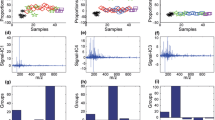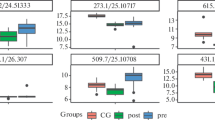Abstract
Metabonomics has become a very valuable tool and many research fields rely on results coming out from this combination of analytical techniques, chemometric strategies, and biological interpretation. Moreover, the matrices are more and more complex and the implications of the results are often of major importance. In this context, the need for pertinent validation strategies comes naturally. The choice of the appropriate chemometric method remains nevertheless a difficult task due to particularities such as: the number of measured variables, the complexity of the matrix and the purposes of the study. Consequently, this paper presents a detailed metabonomic study on human urine with a special emphasis on the importance of assessing the data's quality. It also describes, step by step, the statistical tools currently used and offers a critical view on some of their limits. In this work, 29 urine samples among which 15 samples obtained from tetrahydrocannabinol (delta-9-tetrahydrocannabinol)-consuming athletes, 5 samples provided by volunteers, and 9 samples obtained from athletes were submitted to untargeted analysis by means of ultra high-pressure liquid chromatography–electrospray ionization–time-of-flight mass spectrometry. Next, the quality of the obtained data was assessed and the results were compared to those found in databases. Then, unsupervised (principal component analysis (PCA)) and supervised (ANOVA/PCA, partial least-square–discriminant analysis (PLS-DA), orthogonal PLS-DA) univariate and multivariate statistical methods were applied.

ᅟ









Similar content being viewed by others
Abbreviations
- ANOVA:
-
Analysis of variance
- CE-MS:
-
Capillary electrophoresis-mass spectrometry
- CV:
-
Coefficient of variation
- GC-MS:
-
Gaseous chromatography–mass spectrometry
- LC-MS:
-
Liquid chromatography–mass spectrometry
- LC-ToF:
-
Liquid chromatography–time-of-flight mass spectrometry
- NMR:
-
Nuclear magnetic resonance
- OPLS:
-
Orthogonal partial least-square analysis
- PCA:
-
Principal component analysis
- PLS-DA:
-
Partial least-square–discriminant analysis
- QC:
-
Quality control
- THC:
-
Tetrahydrocannabinol delta-9-tetrahydrocannabinol; (6aR,10aR)-6,6,9-trimethyl-3-pentyl-6a,7,8,10a-tetrahydrobenzo[c]chromen-1-ol
- UHPLC-ESI/ToF:
-
Ultra high-pressure liquid chromatography–electrospray ionization–time-of-flight mass spectrometry
References
Robertson DG, Watkins PB, Reily MD (2011) Metabolomics in toxicology: preclinical and clinical applications. Toxicol Sci 120:S146–S170
Robertson DG, Reily MD, Baker JD (2007) Metabonomics in pharmaceutical discovery and development. J Proteome Res 6:526–539
Dieterle F, Marrer E (2008) New technologies around biomarkers and their interplay with drug development. Anal Bioanal Chem 390:141–154
Bao YQ, Zhao T, Wang XY, Qiu YP, Su MM et al (2009) Metabonomic variations in the drug-treated type 2 diabetes mellitus patients and healthy volunteers. J Proteome Res 8:1623–1630
Wagner S, Scholz K, Donegan M, Burton L, Wingate J et al (2006) Metabonomics and biomarker discovery: LC-MS metabolic profiling and constant neutral loss scanning combined with multivariate data analysis for mercapturic acid analysis. Anal Chem 78:1296–1305
Koulman A, Lane GA, Harrison SJ, Volmer DA (2009) From differentiating metabolites to biomarkers. Anal Bioanal Chem 394:663–670
Ahmed S, Santosh W, Kumar S, Christlet HTT (2009) Metabolic profiling of Parkinson's disease: evidence of biomarker from gene expression analysis and rapid neural network detection. J Biomed Sci 16
Zhang AH, Sun H, Wang XJ (2012) Serum metabolomics as a novel diagnostic approach for disease: a systematic review. Anal Bioanal Chem 404:1239–1245
Yap IKS, Brown IJ, Chan Q, Wijeyesekera A, Garcia-Perez I et al (2010) Metabolome-wide association study identifies multiple biomarkers that discriminate north and south Chinese populations at differing risks of cardiovascular disease INTERMAP Study. J Proteome R 9:6647–6654
Wang XJ, Lv HT, Zhang GM, Sun WJ, Zhou DX et al (2008) Development and validation of a ultra performance LC-ESI/MS method for analysis of metabolic phenotypes of healthy men in day and night urine samples. J Sep Sci 31:2994–3001
Xu EY, Schaefer WH, Xu QW (2009) Metabolomics in pharmaceutical research and development: metabolites, mechanisms and pathways. Curr Opin Drug Discov Dev 12:40–52
Lindon JC, Holmes E, Nicholson JK (2006) Metabonomics techniques and applications to pharmaceutical research and development. Pharm Res 23:1075–1088
Nordstrom A, Lewensohn R (2010) Metabolomics: moving to the clinic. J Neuroimmune Pharm 5:4–17
Guy PA, Tavazzi I, Bruce SJ, Ramadan Z, Kochhar S (2008) Global metabolic profiling analysis on human urine by UPLC-ToFMS: Issues and method validation in nutritional metabolomics. J Chromatogr B-Analytical Tech Biomed Life Sci 871:253–260
Kaplan KA, Chiu VM, Lukus PA, Zhang X, Siems WF et al (2013) Neuronal metabolomics by ion mobility mass spectrometry: cocaine effects on glucose and selected biogenic amine metabolites in the frontal cortex, striatum, and thalamus of the rat. Anal Bioanal Chem 405:1959–1968
Courant F, Pinel G, Bichon E, Monteau F, Antignac JP et al (2009) Development of a metabolomic approach based on liquid chromatography-high resolution mass spectrometry to screen for clenbuterol abuse in calves. Analyst 134:1637–1646
Werner E, Heilier JF, Ducruix C, Ezan E, Junot C et al (2008) Mass spectrometry for the identification of the discriminating signals from metabolomics: current status and future trends. J Chromatogr B-Analytical Tech Biomed Life Sci 871:143–163
Pasikanti KK, Ho PC, Chan ECY (2008) Gas chromatography/mass spectrometry in metabolic profiling of biological fluids. J Chromatogr B-Analytical Tech Biomed Life Sci 871:202–211
Leon C, Rodriguez-Meizoso I, Lucio M, Garcia-Canas V, Ibanez E et al (2009) Metabolomics of transgenic maize combining Fourier transform-ion cyclotron resonance-mass spectrometry, capillary electrophoresis-mass spectrometry and pressurized liquid extraction. J Chromatogr A 1216:7314–7323
Lu X, Zhao XJ, Bai CM, Zhao CX, Lu G et al (2008) LC-MS-based metabonomics analysis. J Chromatogr B-Analytical Tech Biomed Life Sci 866:64–76
Hodavance MS, Ralston SL, Pelczer I (2007) Beyond blood sugar: the potential of NMR-based metabonomics for type 2 human diabetes, and the horse as a possible model. Anal Bioanal Chem 387:533–537
Dettmer K, Aronov PA, Hammock BD (2007) Mass spectrometry-based metabolomics. Mass Spectrom Rev 26:51–78
Lenz EM, Wilson ID (2007) Analytical strategies in metabonomics. J Proteome Res 6:443–458
Plumb RS, Rainville P, Smith BW, Johnson KA, Castro-Perez J et al (2006) Generation of ultrahigh peak capacity LC separations via elevated temperatures and high linear mobile-phase velocities. Anal Chem 78:7278–7283
Grata E, Boccard J, Guillarme D, Glauser G, Carrupt PA et al (2008) UPLC-ToF-MS for plant metabolomics: a sequential approach for wound marker analysis in Arabidopsis thaliana. J Chromatogr B-Analytical Tech Biomed Life Sci 871:261–270
Kim KB, Chung MW, Um SY, Oh JS, Kim SH et al (2008) Metabolomics and biomarker discovery: NMR spectral data of urine and hepatotoxicity by carbon tetrachloride, acetaminophen, and d-galactosamine in rats. Metabolomics 4:377–392
Zhao LC, Liu X, Xie LY, Gao HC, Lin DH (2010) 1H NMR-based metabonomic analysis of metabolic changes in streptozotocin-induced diabetic rats. Anal Sci 26:1277–1282
Jahns GL, Kent MN, Burgoon LD, DelRaso N, Zacharewski TR et al (2009) Development of analytical methods for NMR spectra and application to a C-13 toxicology study. Metabolomics 5:253–262
Stenlund H, Gorzsas A, Persson P, Sundberg B, Trygg J (2008) Orthogonal projections to latent structures discriminant analysis modeling on in situ FT-IR spectral imaging of liver tissue for identifying sources of variability. Anal Chem 80:6898–6906
Miyagi A, Takahashi H, Takahara K, Hirabayashi T, Nishimura Y et al (2010) Principal component and hierarchical clustering analysis of metabolites in destructive weeds; polygonaceous plants. Metabolomics 6:146–155
Viant MR, Ludwig C, Rhodes S, Guenther UL, Allaway D (2007) Validation of a urine metabolome fingerprint in dog for phenotypic classification. Metabolomics 3:453–463
Li XY, Legido-Quigley C (2008) Advances in separation science applied to metabonomics. Electrophoresis 29:3724–3736
Lauridsen M, Hansen SH, Jaroszewski JW, Cornett C (2007) Human urine as test material in H-1 NMR-based metabonomics: recommendations for sample preparation and storage. Anal Chem 79:1181–1186
Fonville JM, Richards SE, Barton RH, Boulange CL, Ebbels TMD et al (2010) The evolution of partial least squares models and related chemometric approaches in metabonomics and metabolic phenotyping. J Chemom 24:636–649
Wagner S, Scholz K, Sieber M, Kellert M, Voelkel W (2007) Tools in metabonomics: an integrated validation approach for LC-MS metabolic profiling of mercapturic acids in human urine. Anal Chem 79:2918–2926
Sumner LW, Amberg A, Barrett D, Beale MH, Beger R et al (2007) Proposed minimum reporting standards for chemical analysis. Metabolomics 3:211–221
Beckonert O, Bollard ME, Ebbels TMD, Keun HC, Antti H et al (2003) NMR-based metabonomic toxicity classification: hierarchical cluster analysis and k-nearest-neighbour approaches. Anal Chim Acta 490:3–15
Ramadan Z, Jacobs D, Grigorov M, Kochhar S (2006) Metabolic profiling using principal component analysis, discriminant partial least squares, and genetic algorithms. Talanta 68:1683–1691
Gika HG, Theodoridis GA, Wilson ID (2008) Liquid chromatography and ultra-performance liquid chromatography-mass spectrometry fingerprinting of human urine—sample stability under different handling and storage conditions for metabonomics studies. J Chromatogr A 1189:314–322
Gika HG, Theodoridis GA, Wingate JE, Wilson ID (2007) Within-day reproducibility of an HPLC-MS-Based method for metabonomic analysis: application to human urine. J Proteome Res 6:3291–3303
Sangster T, Major H, Plumb R, Wilson AJ, Wilson ID (2006) A pragmatic and readily implemented quality control strategy for HPLC-MS and GC-MS-based metabonomic analysis. Analyst 131:1075–1078
Craig A, Cloareo O, Holmes E, Nicholson JK, Lindon JC (2006) Scaling and normalization effects in NMR spectroscopic metabonomic data sets. Anal Chem 78:2262–2267
van den Berg RA, Hoefsloot HCJ, Westerhuis JA, Smilde AK, van der Werf MJ (2006) Centering, scaling, and transformations: improving the biological information content of metabolomics data. BMC Genomics 7
Eriksson L, Antti H, Gottfries J, Holmes E, Johansson E et al (2004) Using chemometrics for navigating in the large data sets of genomics, proteomics, and metabonomics (gpm). Anal Bioanal Chem 380:419–429
Trygg J, Wold S (2002) Orthogonal projections to latent structures (O-PLS). J Chemom 16:119–128
Hedenstrom M, Wiklund S, Sundberg B, Edlund U (2008) Visualization and interpretation of OPLS models based on 2D NMR data. Chemom Intell Lab Syst 92:110–117
Acknowledgments
The authors would like to acknowledge the contribution of the Rhone-Alpes Regional Council and the French anti-Doping Agency for the samples necessary to this work. We would also like to thank Aurélie Fildier for her technical help for the high resolution mass spectrometry.
Author information
Authors and Affiliations
Corresponding author
Additional information
Published in the special issue Analytical Science in France with guest editors Christian Rolando and Philippe Garrigues.
Electronic supplementary material
Below is the link to the electronic supplementary material.
ESM 1
(PDF 167 kb)
Rights and permissions
About this article
Cite this article
Kiss, A., Bordes, C., Buisson, C. et al. Data-handling strategies for metabonomic studies: example of the UHPLC-ESI/ToF urinary signature of tetrahydrocannabinol in humans. Anal Bioanal Chem 406, 1209–1219 (2014). https://doi.org/10.1007/s00216-013-7199-0
Received:
Revised:
Accepted:
Published:
Issue Date:
DOI: https://doi.org/10.1007/s00216-013-7199-0




